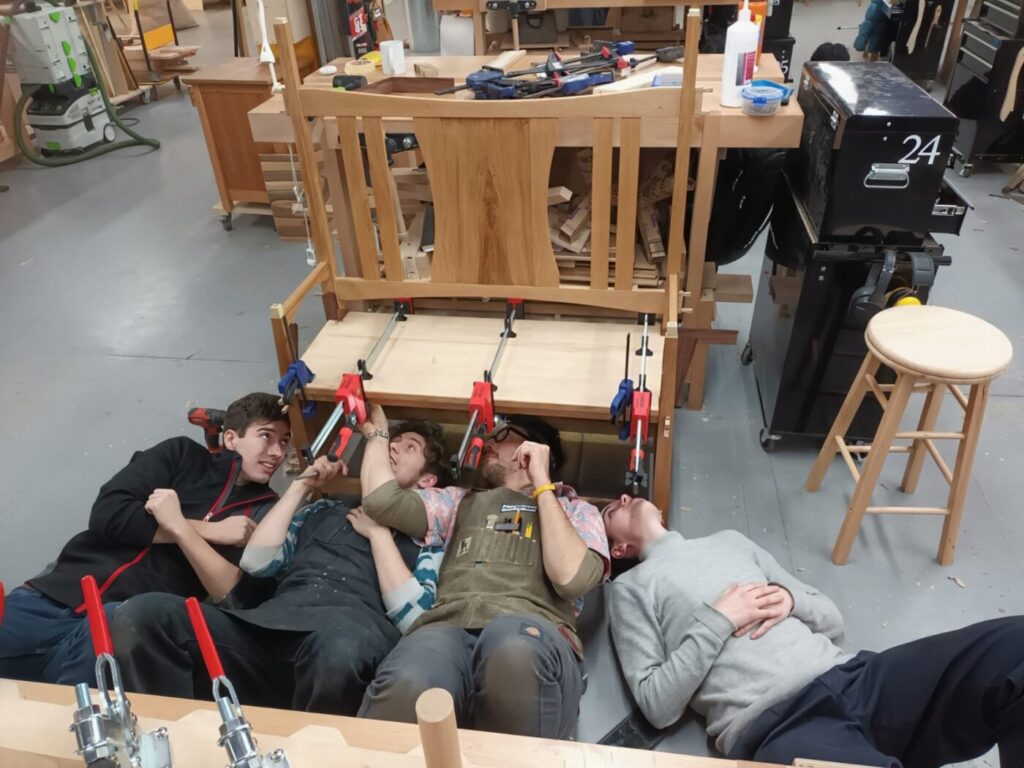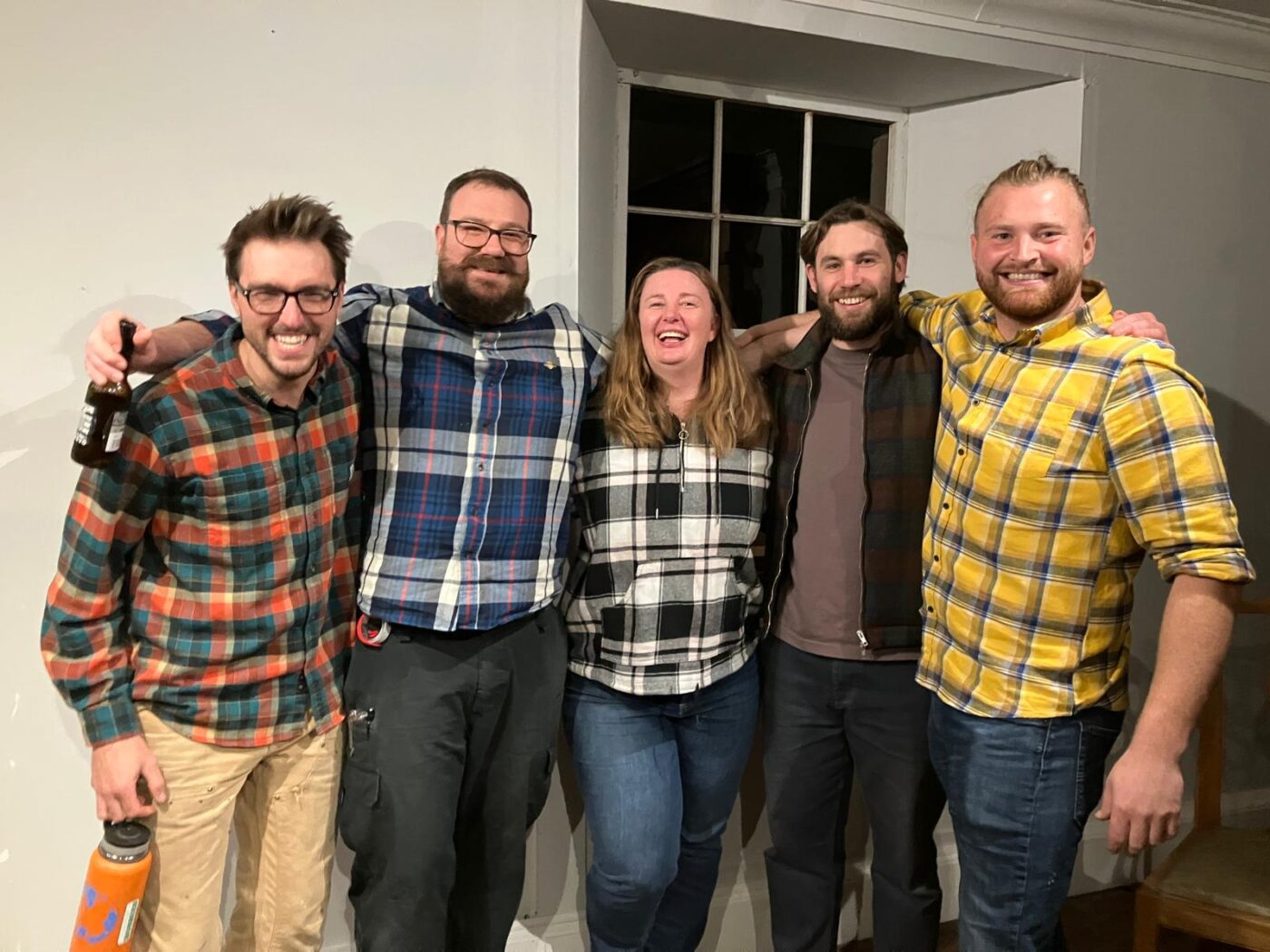“I learned more in one day being part of the collective school experience than I would reading a book by myself.”
Arizona-based Jean-Philippe is no stranger to awe-inspiring landscapes, something that made his journey to Scotland all the more perfect. With support from his family, he enrolled on Chippendale’s Professional Course and spent the next 9 months working on his passion for woodworking and fine furniture making. Now back in the USA and focused on expanding his woodworking business, we caught up with Jean-Philippe to learn more about why he chose to attend Chippendale and what he gained from the experience.
How did your journey into furniture making begin?
My journey into furniture making quite literally began on the side of a mountain! Before Chippendale, I worked in outdoor education and conservation and my first-ever project was seeing our crew build a bridge over a river. Armed with only hand tools and the materials available to us, we felled a tree, shaped it up, built a rock abutment, and made a simple bridge. Bug caught.
I read books, watched instructional videos, and continuously practised, eventually feeling confident enough to make the crib for my newborn daughter. Three years later she, my spouse and I moved to Scotland to follow my dream.

What attracted you to study at Chippendale School of Furniture?
There were several reasons why I was drawn to Chippendale, namely the bucolic nature of a furniture making school based in the Scottish countryside. That said, what sold me was the atmosphere. I told myself I was never going to go back to school, I’m not a school-type. The beauty of a course like this is that it isn’t school, it is a collective of creative individuals all there to learn something they are passionate about.
I chose Chippendale because I needed to have a shared experience with others, learn more about the tools and techniques, find a way to explore how to design projects under tutelage (and not through my self-deprecating brain), spend hours at my bench, AND do this all with my family by my side.
Could you share a standout moment from your time at the Chippendale School?
I’d like to share one of the harder moments of my time at the school, hoping this will resonate with others who are new to woodworking. On my last project with the school, “Little Cabinet with a View”, I had just set my silver gilding on (don’t worry it is easier than you think). It seems on that day my brain and body were operating in different realities and when I completed the work, I hated it. In my mind, I had ruined the whole cabinet. Without thinking too much, I shut the doors, locked it, and took the key home with me so no one would be tempted to look at it. The next morning, I came in early and started trying to “fix” it all by myself. Two of my colleagues saw how frantic I was, stepped in and politely held me back.
I look back on these moments when I needed my community and they were there for me, as the most impactful moments of my woodworking career thus far.

You say Chippendale School is a community. How did the diverse perspectives and approaches of your fellow students at the Chippendale School impact your learning experience?
As I sit here writing, alone in a room after a day spent working solo in the shop, I’m struck by how much I took that community for granted. At Chippendale, I could be in the middle of a project, raise my head and get feedback or answers quickly. Someone might pass by my bench, stop for a chat, share a cup of tea, or offer encouraging thoughts about my work. And I could do the same for others. The community made the experience truly worthwhile, and every single person brought something unique. I learned more in one day being part of the collective school experience, than I would reading a book by myself.
What was the most challenging project you undertook at the Chippendale School, and how did you overcome it?
I believe the most challenging project for most of us was the cherry cabinet. While it wasn’t the most difficult in terms of technical skills, it certainly tested our patience. A group assignment, those with experience were eager to move on, while some found the basics more challenging. The experience taught me a lot about working in a group, pacing myself, and helping others. In the end, 30 little bedside cabinets were made, and I learned the importance of staying curious, asking for help, and appreciating the unique skills each of us brings to the table.

From Arizona’s dramatic scenery to Scotland’s more delicate surroundings, how have the landscapes you’ve worked in influenced your creative process?
Exploring landscapes in my previous careers, I feel most connected to the outdoors and am continually inspired by it. You can see this in my two projects made at school. The Settle is decidedly Scottish. The local oak trees towering above, weathered and gnarled in the harsh environment were used to make it. The design was to show off the delightful Quercus and was modelled after some of Scotland’s (and the UK’s) great furniture pioneers (Mackintosh, Wylie, Lochhead, etc.).
Looking at the Cabinet, the entire scene is that of Arizona. I wanted the cabinet to convey the scene of opening a tent vestibule flap and immersing yourself in the desert. It is a harsh landscape, weathered over time, with stories to tell. I hope to continue being inspired by my environment and the people I share it with.
How do you envision your work evolving as you return home and develop your business?
Now back home, I hope to continue to grow my business. I hope to make beautiful, functional things, that people can have in their homes; sit down on one of my chairs, and eat at one of my tables, that’s the goal of my evolution. One thing that won’t change, however, is my love of learning – you will always find me trying to do better, make mistakes and try again.
Beyond that, I would love to one day teach. I’m eager to use my background in education and my experience as a woodworker to teach the next generation of craftspeople. What we do is important. It is good for the soul, it is good for the planet, and it is worth doing. Let’s share our knowledge, create accessibility in the craft, and open it as an opportunity for everyone.


What advice do you have for aspiring furniture makers considering studying at the Chippendale School of Furniture in Scotland?
I’ll tell you what worked for me. Start without any expectations but have goals. Start as a beginner, even if you have experience. Remain curious. Ask for advice. TAKE that advice. Help others, even when you have more to do. Be present. Do good work. The experience is truly what you make of it.
Tom’s opening theme is about putting in what you want out of the course. Truer words were never spoken.
What will you miss about Scotland?
I’ll miss the people the most. The community I developed in 9 months turned into something I can hardly live without. The problem is that we are all now worlds apart. I find myself still messaging folks, asking for advice, sending ridiculous things, or just generally saying what’s up. I’m grateful for the time I spent with everyone and the time they gave both me and my family. Even my daughter’s 3rd birthday was a rag-tag group of students, local families, and a handmade piñata.
These experiences and these people have shaped me more than this small novel I could come close to describing. Thank you to everyone. Oh, and I’ll miss the Scottish weather!
A huge thank you to Jean-Philippe for taking the time to speak to us. Check out his work at www.jclarkfurniture.com or on Instagram @jclarkfurniture.
—
Are you interested in pursuing a career in woodworking? Take a look at our 30-week Professional Course to see how you too could become a fine furniture maker.
